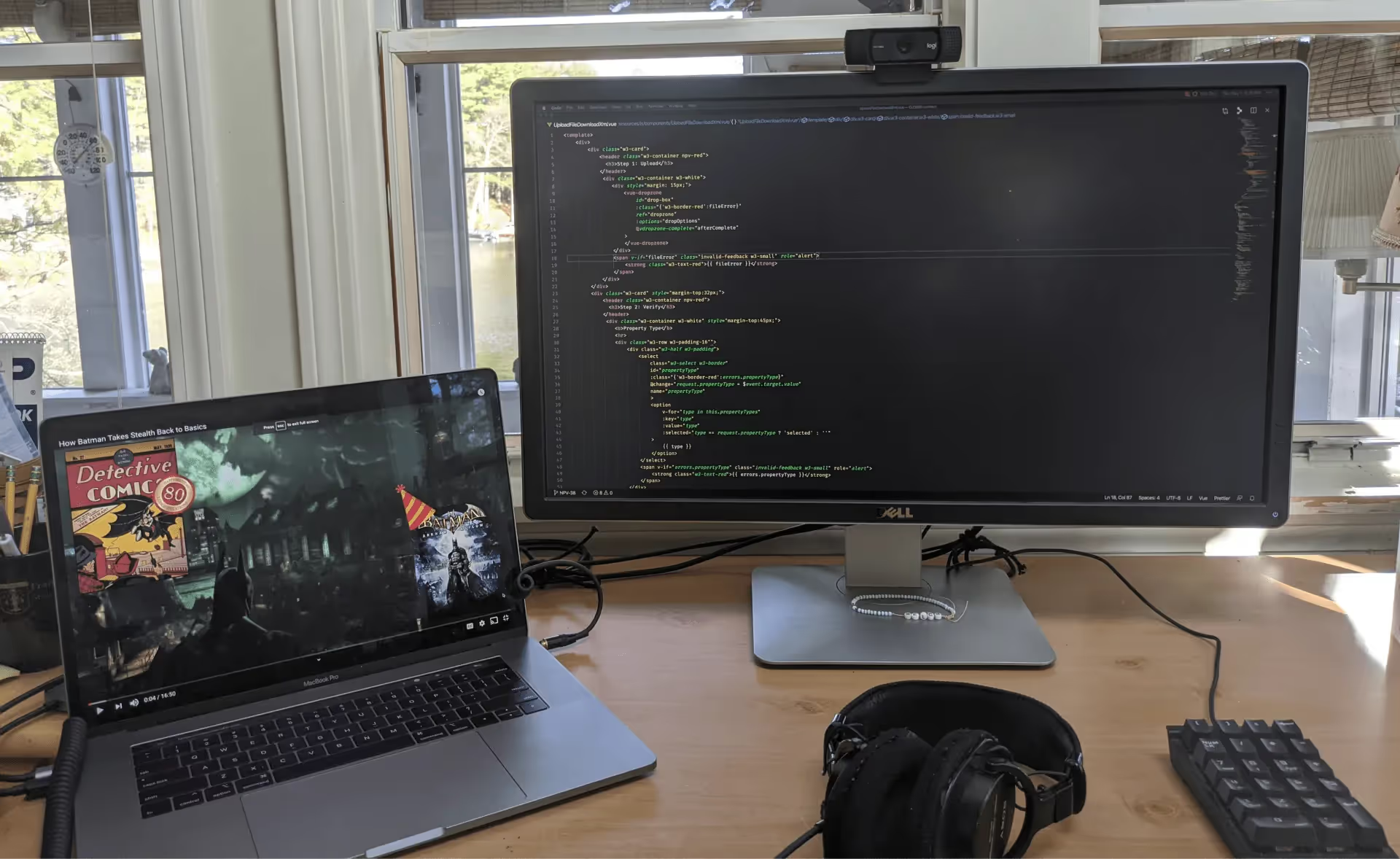Growing up as someone with ADD, I’ve always had to find ways to make things work for me. I’ve had an organized digital calendar longer than almost anyone I know. I was the only middle-schooler I’ve ever known with a Palm Pilot (remember those?). When I was a kid I even had my morning routine printed out and hung on my bedroom door. Eat breakfast, brush teeth, take a shower, etc. I appreciated early on that my brain worked a little differently, and I was going to have to adapt.
After college, I got a job working in internal IT support. With access to all the monitors that weren’t currently in use, I soon found myself with a three monitor setup: two for work, and one that was constantly playing videos. I noticed that having something playing in the background helped me stay focused on whatever problem I was working through. My cube was located in a corner removed from my coworkers and I arranged my monitors so that they pointed away from everyone. Because of my discreteness, I never had to figure out if this set up would have been acceptable, but I definitely worried someone would tell me to stop.
To this day, I “watch” videos non-stop while I work.
This can be fairly confusing to most people. Until they get used to it, I often get odd looks in the office and questions like:
“What are you watching there?”
“Don’t you get distracted watching videos while working?”
Ironically, the interruptions to ask what I’m watching are the most distracting parts of the videos.
Now that I work in software development at Highland, I’ve found that I can keep up my video watching peacefully. I appreciate that I am given the freedom to work the way I want, as unusual as it may be.
“You’re not working from home—you’re at home during a pandemic trying to work.”
I’m sure you’ve seen this quote circulating over the past weeks. While employers are hurriedly trying to shift their entire organizations—some of whom have never had any formal work-from-home policies—to allow for remote work, many are struggling to pivot from their in-office expectations.
In a piece published last month by Medium’s Marker Editors, the inventors of Basecamp and long-time remote work advocates Jason Fried and David Heinemeier-Hansson had a lot to say about how businesses can support work-life balance, especially now:
“Most people initially think that people are going to slack off at home,” Fried said. “Actually, because there’s not as much separation, the bigger risk is overwork. […] My hope is that people look back at this time and see that they ended up getting a lot done and people enjoyed it. And that it will spur companies to revisit the way they work.”
— They Led the Cult of Remote Work. Now We’re All Members, by Adam Bluestein
Working from home can be seen as one of two things: a hindrance, or an opportunity. Old-school employers can benefit from adopting the tried and true (and coveted) remote work methods seen at start-ups and software development firms.
While I was nervous in the past that I might be reprimanded for watching videos while working, it is a relief to know that the mode that works best for me is supported by Highland. Therein lies the key factor in embracing distraction: your employer has to trust you—and you have to trust yourself to keep focused.
Now, this isn’t a how-to piece, but if it was, here are some things I’ve found are helpful:
How to keep focused through distraction—and when to stop. I honestly have no idea how my technique of watching videos works for me. I think it might have something to do with occupying that part of my brain that is constantly looking for new stimuli. Instead of starting to think about another project or problem while in the midst of working on a ticket, I listen to Brad Leone from the Bon Appétit test kitchen talk about garlic and allicin for the umpteenth time.
While this method keeps me focused on the task at hand, I can’t keep up the videos all the time. While writing this I had to turn off the political podcast I had been playing when the words started to get mixed with my own.
In general, I get into the best rhythm when I’m working on something I already know how I’m going to implement or solve. When the problem gets hairy enough and I’m finally using all of my distractable mind, I will then drop the videos altogether and work with lyricless music or just nothing at all.
Spoken word is better Videos that can be understood while barely looking at them work best for me. I watch a lot of video essays about film, video games, and whatever else I’m feeling at the time. I don’t know anything about music theory but I learned about it while working. Anything that ends up like a podcast with visuals is a pretty good pick. Though I thoroughly enjoy a good Primitive Technology video, the lack of vocals means I would have to constantly be looking over at the monitor to understand anything. Avoid anything that consumes your full attention.
Rewriting The Matrix Sequels by Patrick (H) Willem - YouTube
Pick something long I generally try and find videos that are at a minimum of 10 minutes long— half an hour and up is even better. The moment you’re spending more time picking videos than working you start defeating the purpose.
Find a groove, then ride the algorithm While long videos are good, sometimes you can just rely on quantity. YouTube will just keep playing videos similar to the last one you watched, meaning that if you start watching some Bon Appétit cooking vids, you might find yourself taking a trip through all sorts of YouTube cooking stars. Some Binging With Babish, some Adam Ragusea. Once you find a creator or channel that works for you, consider putting on one of their playlists.
When solving a hard problem, pick something familiar When I really need to get something done, I end up re-watching videos that I’ve seen many times before. Monster Factory from the McElroy brothers and Polygon is one of my favorite series. It’s just all-around positive, and I know exactly what’s happening so I end up laughing along even when I’m not looking at the video.
Embrace the freedom to work the way you need to
One of the worst professors I had in college banned all computers and phones in class. No matter how many times I talked to her about how the ability look up additional information actually kept me more engaged, she refused to believe that access to those resources could lead me to pay more attention than less.
Next time you see someone working in a way that doesn’t make sense to you, take the time to figure out how it works for them. Stop yourself from jumping straight into telling them to adapt to the way that you think they should be working.
Are you familiar with your Learner Persona? Thinking about the Learner Experience (LX) might help you figure out which working and learning style suits your unique needs:
Learner Experience (LX) 5 Questions to Help You Determine Personas
I’m fortunate and happy that I’ve found a home at a company that doesn’t feel the need to mandate how I can work, or assumes that just because I may be working a little differently automatically means I’m being less productive. I hope anyone reading this understands my odd working habit a little better—and if you still don’t understand me, I hope you at least got some good video recommendations.



